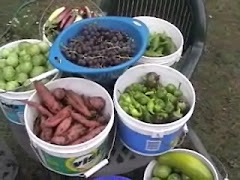Late spring spinach (note the outline of a worm in bottom corner)

Flat of Egypt beet greens

Swiss chard

The small gray flies lay their eggs in neat little clusters on the underside of the leaves. As the maggots emerge they get in between the leaf tissue mining their way throughout the leaves as they feed.
As the maggots emerge they get in between the leaf tissue mining their way throughout the leaves as they feed. The first of the many cycles they go through each year seem to be the most damaging for our crops and as the season progresses the damage inflicted becomes less noticeable. The only solution I have come up with to combat these little nasties is to pull off the tunnelled leaves and feed them to our ravenous chickens.
The first of the many cycles they go through each year seem to be the most damaging for our crops and as the season progresses the damage inflicted becomes less noticeable. The only solution I have come up with to combat these little nasties is to pull off the tunnelled leaves and feed them to our ravenous chickens.
One thing I am going to do is allow the birds into the garden for a brief period this fall and the following spring to help combat any overwintering insects. If anyone has found an organic method of relieving themselves of these exasperation's please do tell.
"Too close a look can oft temper ones enthusiasm for a natural salad" - Mike :)






















9 comments:
That's one way to get more protein in your diet...;) I don't know anything about leafminers except that they are extremely hard to get rid of. Good thing you do have wasps that eat some of the maggots. We haven't had them here yet in our tiny garden... :) Silke
You could try spinosad. It's a treatment that is derived from a bacterium and works on many different chewing insects (approved for organic crops). Here's a link to Peaceful Valley (an organic farm and garden supply source online): http://www.groworganic.com/item_PBI800_Monterey_Garden_Spray_Concentrat.html
There are links there to the Material Safety Data Sheet and the product label so you can see if it is something you would want to use.
I've purchased this product from them and have used it when the damage from chewing insects just gets to be too out of control. It has worked on leafminers for me.
I'm not sure that your chickens would approve of the loss of their buggy snacks though :)
Hmmm. Michelle's idea sounds interesting. I don't grow spinach much any more and hardly any beets -- the leafminers are just too bad. I know floating row covers are supposed to help, but in your case that's probably impractical because of the space. I may try it though -- I love spinach so much and otherwise it grows really well here.
Silke,
Yes, I often wonder what extra protein we do ingest.:)
Stefaneener,
In our garden the problem becomes less of an issue later in the season. But yes, it makes one question growing certain crops... for me it is Swiss chard. I hope you try Michelle's spinosad, and it works, because no garden should be without beets, chard, or spinach.:)
Mr H, I will be very interested to know how it works for you. Glad to help!
Well nothing like hens or geese to do a great job of these things.
Eag,
The birds are a wonderful addition to our garden area. They are able to range around 3/4 of the garden perimeter and the one side they do not have access to is the only place we still have issues with voles (mice like monsters that eat my garden veggies
Michelle,
I just looked it up and it sounds interesting.
From Wikipedia: Spinosad - The active ingredient is derived from a naturally occurring soil dwelling bacterium called Saccharopolyspora spinosa, a rare actinomycete reportedly collected from soil in an abandoned rum distillery on a Caribbean Island in 1982 by a scientist on vacation. It has not been found in nature since that time, and was subsequently described as a new species.
Spinosad has since been formulated into insecticides that combine the efficacy of a synthetic insecticide with the benefits of a biological pest control organism.
It is used to control a variety of insect pests, including fruit flies, caterpillars, LEAFMINERS, thrips, sawflies, spider mites, fire ants, and leaf beetle larvae.
Spinosad is recommended for use in an Integrated Pest Management program for commercial greenhouses since it will not harm most beneficial insects or predatory mites.
Spinosad does not significantly affect beneficial organisms including ladybugs, green lacewings, minute pirate bugs, and predatory mites.
Post a Comment